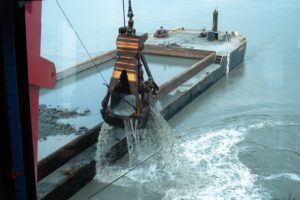Hooe Lake and Plym (Heavy Metals in mud sediments)

With recent proposals to dredge the Plym for a new marina – and any future plans for Hooe Lake – an important environmental issue is the accumulation of toxic sediments in the mud notably Mercury, Tributyltin Tin (TBT), arsenic and lead. These ‘Heavy Metals’ can be associated with rivers / natural geology, mining, Dockyards, leaching from waste tips, anthropogenic sources & sewage discharges.
Along with Mercury in the sediments of Hooe Lake there is the accumulation of Tributyltin TBT used as a ship / boat anti fouling until banned in 1988 in UK and lead fuel additive that has leached from the old MOD fuel storage tanks at Radford used for aviation fuel for sea planes at Mount Batten during the war.
This is the reason why commercial shell fishing beds are banned from the Plym and Hooe Lake as the filter feeders (Oysters, cockles, etc) concentrate the heavy metal and sewage pollutants and would have a serious risk to human consumption.
TBT produces gender & other physiological changes in marine species.
Any dredging operation no matter the method used would create a plume of contaminated suspended sediments that would be dispersed on the tides through the estuaries. The re-suspended heavy metal pollutants would settle on slack tides and contaminated the fish feeding grounds. As larger feeding fish are higher up the food chain; this would impact on the health of migratory Salmon, Sea Trout and other commercial fish species hence health risks for human consumption.
Relevant documents.
1. The distribution of mercury in the sediments of the plym estuary
Environmental Pollution Series B, Chemical and Physical, Volume 2, Issue 4, July 1981, Pages 265-274. G. E. Millward, I. Herbert.
This research concluded that the high concentrations of Mercury (Hg) in Hooe Lake and Plym Estuary are associated with sewage outfalls at Marsh Mills and Radford Sewage Works.
2. Plymouth Sound and Estuaries.
MBA Occasional Publication No.9, 2003. W.J. Langston, B.S.Chesman, G.R.Burt, S.J.Hawkins, J.Readman, P.Worsfold.
This is an extensive review of the Tamar, Lynher and Plym Estuaries marine life, sediments, pollutants & sources, prepared by the Marine Biological Association, Plymouth University and Plymouth Marine Laboratory, for the Environment Agency and English Nature.
3. Articles from Wikipedia
Tributyltin
TBT compounds are considered as toxic chemicals which have negative effects on human and environment. Tributyltin compounds are moderately to highly persistent organic pollutants that bioconcentrate up the marine predators’ food chain
Mercury in fish
Fish products have been shown to contain varying amounts of heavy metals, particularly mercury and fat-soluble pollutants from water pollution. Species of fish that are long-lived and high on the food chain, such as marlin, tuna, shark, swordfish, king mackerel, tilefish, northern pike, and lake trout contain higher concentrations of mercury than others.
For these reasons there should be high concerns over any dredging in Hooe Lake or the Plym which could have a serious affect on the health of marine life in the Tamar Estuaries.
Anonymous